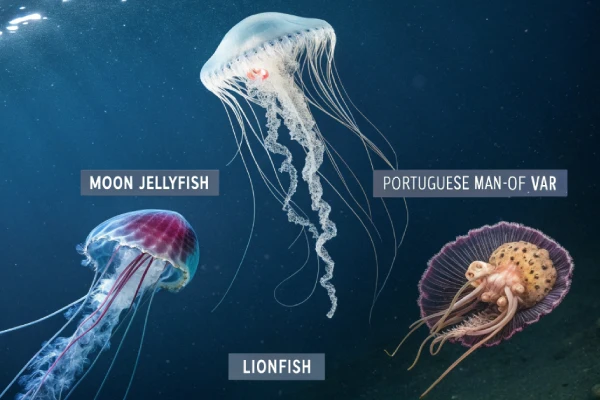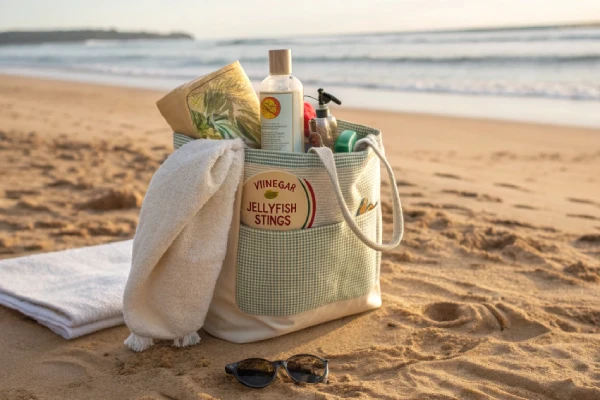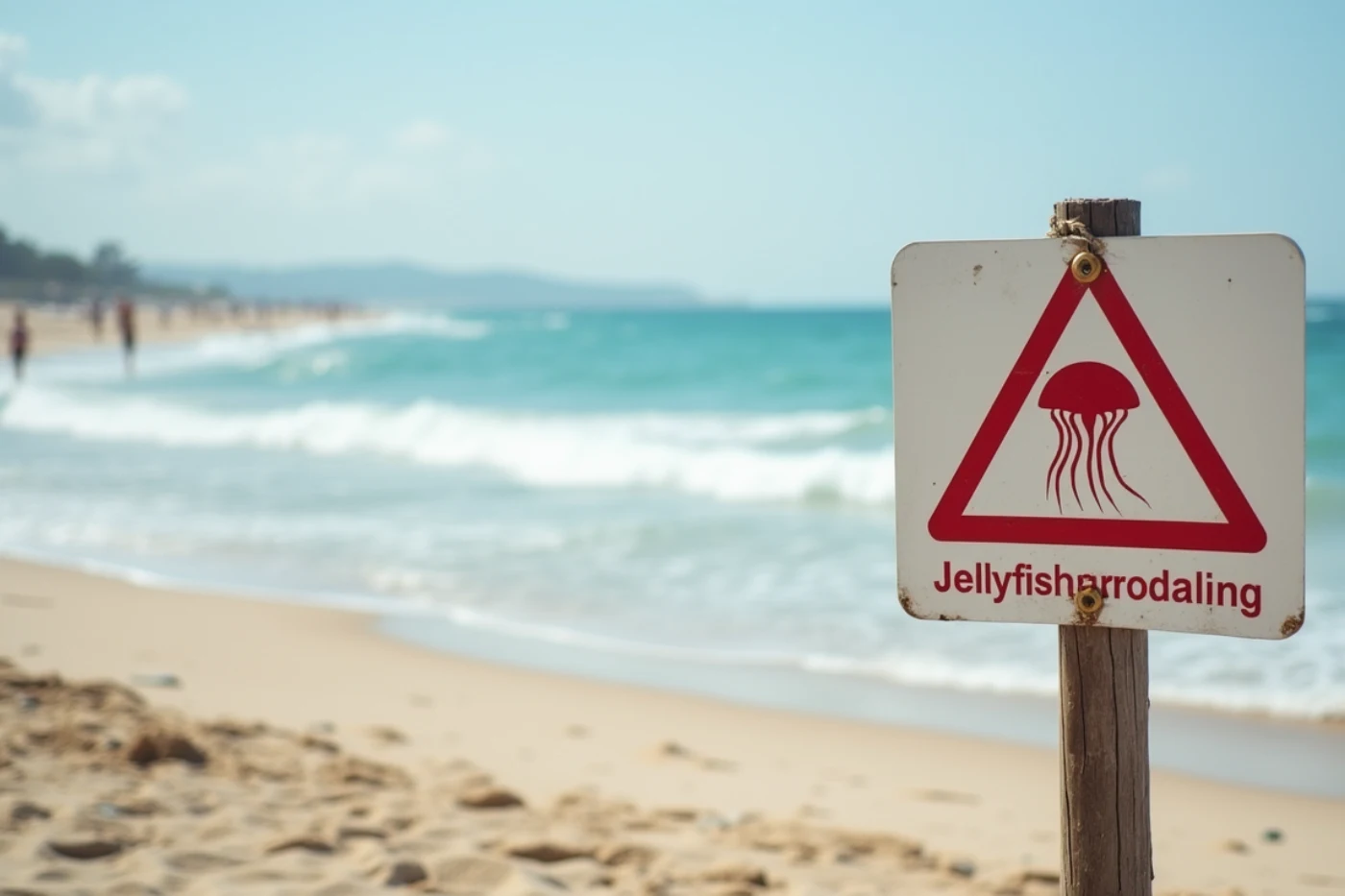Table of Contents
Introduction
Imagine this: you’re ready for a perfect day at the beach, the sun is shining, and the waves are gently rolling in. Suddenly, a warning sign about jellyfish stings catches your eye. It’s enough to send shivers down your spine, right? Jellyfish are a common occurrence along U.S. coastlines, and while they might seem intimidating, a little preparation can keep your beach days enjoyable and sting-free.
According to recent statistics, jellyfish incidents in the U.S. have been on the rise, particularly in regions like the Gulf Coast and Southern California. This increase is attributed to various factors, including shifting ocean currents, changes in water temperature, and overall growth in jellyfish populations. Understanding how to avoid jellyfish stings is crucial for both tourists and locals, ensuring safe and enjoyable beach experiences for everyone. Follow essential beach safety measures to stay protected.
Let’s dive into how you can avoid jellyfish stings at USA beaches and ensure your next beach adventure is nothing but fun and sun.
Understanding Jellyfish Stings

Jellyfish stings can be a painful experience, but understanding how they occur can help you avoid them. Jellyfish have thousands of stinging cells, called nematocysts, located on their tentacles. These cells release venom upon contact, causing the sting. Common jellyfish species in U.S. coastal waters include the moon jellyfish, Portuguese man-of-war, and lionfish.
Symptoms of a jellyfish sting range from mild pain, redness, and swelling to more severe reactions in rare cases. It’s important to note that not everyone reacts the same way to a jellyfish sting. Factors such as the species of jellyfish, the size of the affected area, and an individual’s sensitivity can influence the severity of symptoms.
Top 10 Beach Safety Tips to Avoid Jellyfish Stings
1. Check Beach Warnings and Flags
Before diving into the water, always check for beach warnings and flags. Lifeguards place these indicators to inform visitors about potential hazards, including jellyfish. Different flags may signal various warnings, so it’s essential to understand what each one represents. For example, a red flag might indicate high surf conditions, while a purple flag could signify the presence of dangerous marine life like jellyfish.
2 . Avoid Swimming During Jellyfish Season
Jellyfish seasons vary by region. For instance, the Gulf of Mexico has higher activity in summer, while parts of California see blooms in fall. To minimize your risk, avoid swimming during these peak times. Understanding the patterns of jellyfish migration and breeding in your area can help you plan your beach days more strategically.
3. Wear Protective Clothing

Wearing rash guards, wetsuits, or swim leggings creates a barrier between you and jellyfish tentacles, reducing the risk of stings. Certain materials are more effective than others, so it’s worth researching to find swimwear that offers both comfort and protection.
4. Stay Away from Washed-Up Jellyfish
Even dead jellyfish can pose a threat. Their tentacles can still sting, so keep a safe distance from any washed-up remains. Understanding why dead jellyfish can still be dangerous involves knowing that their stinging cells remain active post-mortem.
5 . Swim in Designated Areas
Stick to lifeguard-monitored zones. These areas are usually safer, as lifeguards can assist if needed. Lifeguards are also trained to handle jellyfish incidents, adding a layer of reassurance for beachgoers.
6. Use Jellyfish Repellent Lotions
Consider using FDA-approved jellyfish repellent lotions to further protect against stings. These products often contain specific ingredients that are effective in repelling jellyfish, providing an added layer of protection.
7. Avoid Water After Storms
Storms can disturb waters, bringing jellyfish closer to shore. Avoid swimming in these conditions to reduce your risk of encountering jellyfish.
8. Shuffle Your Feet in Shallow Water
Shuffling feet prevent accidentally stepping on resting jellyfish or disturbing their nests in the sand. This simple action can significantly reduce your chances of encountering jellyfish in shallow areas.
9. Carry Vinegar in Your Beach Kit

Vinegar can neutralize stinging cells. Keep a bottle handy for immediate first aid if a sting occurs. However, it’s worth noting that alternatives like saltwater or certain medications can also be effective in neutralizing stings.
10. Educate Children About Jellyfish
Children may be tempted to touch jellyfish. Teaching them to avoid contact to prevent stings is crucial. Incorporating fun and engaging methods to educate children can make this process more effective.
What to Do If You’re Stung
Immediate first aid is crucial after a jellyfish sting. Rinse the area with vinegar, remove any tentacles with tweezers, and soak the affected area in hot water. Seek medical attention if you experience severe allergic reactions or extensive stings.
Real-life scenarios can help illustrate the effectiveness of these first aid steps. For example, if someone has a severe allergic reaction, they should seek professional medical help immediately. Understanding how to properly remove tentacles without causing further injury is another critical aspect of first aid.
U.S. Beaches with High Jellyfish Activity
Certain beaches are more prone to jellyfish. These include Florida’s Gulf Coast, Southern California, and the Outer Banks. Understanding why these areas are more prone to jellyfish involves considering factors like environmental conditions and ecological factors that attract jellyfish populations.
Always check local resources for real-time updates before heading out. This proactive approach can help you stay informed and prepared for any potential jellyfish activity in the area. Explore some of the best family-friendly beach destinations in the USA
(FAQs) About How To Avoid Jellyfish Stings at USA Beaches
How Long Does Jellyfish Sting Pain Last?
Pain from most stings fades within 24–48 hours, depending on the species and sting severity. Mild stings (e.g., from moon jellies) may resolve faster, while larger species like the Portuguese man o’ war can cause longer discomfort. Use pain relievers or antihistamines for relief. Seek medical help if pain persists beyond 72 hours or spreads.
Are Jellyfish Stings Lethal in the U.S.?
Deaths are rare, but severe allergic reactions (anaphylaxis) can occur. Most U.S. species, like cannonball jellyfish, pose minor risks. Box jellyfish (found in Florida/Hawaii) require caution. Watch for breathing issues or swelling and seek emergency care immediately if they arise.
Can You Swim at Night to Avoid Jellyfish?
Night swimming isn’t foolproof—many jellyfish drift invisibly in currents. Some, like mauve stingers, are active after dark. If swimming at night, wear protective gear, use a light, and stay in shallow areas. Always check local advisories first.
Does Urine Help with Jellyfish Stings?
No—urine can worsen stings by triggering lingering tentacle cells. Use vinegar to neutralize toxins, remove tentacles with tweezers, and soak the area in hot water (104–113°F). Avoid ice, alcohol, or rubbing the wound.
By following these tips, you can enjoy your beach days with confidence. Jellyfish stings are avoidable with the right precautions. Share this guide with family and friends to help everyone stay safe. Let’s make this summer your most enjoyable yet—sting-free! Looking for beaches with fewer marine dangers? Here are some top shark-free beaches
Conclusion
Jellyfish stings can be an unpleasant surprise, but with the right precautions, you can avoid jellyfish stings at USA beaches and enjoy a worry-free experience. Stay informed about jellyfish seasons, check beach warning flags, wear protective clothing, and carry essentials like vinegar in your beach kit.
Always check local reports before heading out and educate your family on beach safety. With these simple steps, you can make the most of your beach adventures—without the sting! Stay safe, enjoy the waves, and share this guide to help others stay protected.


